Documentation and e-Learning (Part 5): Get Real! − Try “Augmented Reality”
By Dave Powell, Documentation Manager, SyberWorks, Inc.
In the first part of this Get Real series, I suggested that real-time (or near-real-time) web data and web-cam feeds are a great way to pull the real world into online training. This is especially valuable in “book subjects” like astronomy, geology, and marine biology. But what if your customers need to learn to run a new factory-floor machine, repair a car, or perform some other real live process? Or what if they need to understand a complex… perhaps even invisible… phenomenon? Computer simulations help to demonstrate these things, but again, there's no experience like a real interactive one.
This second episode of Get Real describes a powerful new training technology called “Augmented Reality” (AR), which we all may be using within 5 years. What you are about to see might seem unbelievable, but people… perhaps even your competitors… are doing it now with readily available software on ordinary personal computers. And their AR-based training content could be used today on the SyberWorks Training Center or any other LMS that supports web-based courses.
e-Learning Goes Hollywood
Augmented Reality is the dynamic mixing of web-cam feeds with computer-generated images, UI elements, and text. For decades, Hollywood has combined film footage with computer-generated images, but that’s not what we’re talking about here. (Nor are we talking about “holodecks”… at least not yet.) True AR mixes dynamic, interactive computer-generated data and images with live web-cam feeds… in real-time.
Universities and companies have been perfecting this technology since the early 1990s. And you can learn a lot about it by Googling “augmented reality” AND these terms:
- e-learning OR e learning
- adobe
- flash
- microsoft
- toolkit
That’ll keep you busy for hours (YouTube alone hosted nearly 8,000 AR-related videos at this writing). But if you don’t have hours to spare, here are four great demos that I found (make sure your PC speakers are on):
- This R&D video from BMW is the best example I’ve seen of using AR to both teach users a real-time process (car repair), and then guide trained repairmen who are performing the process on the shop floor. (The stills below don’t do it justice… You've GOT to watch it!) http://www.youtube.com/watch?v=P9KPJlA5yds&feature=related
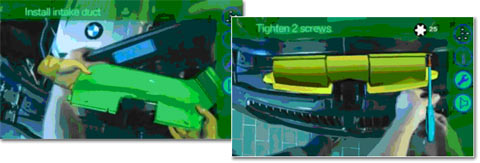
- Here’s a Homeland Security firefighting/haz-mat application that realistically trains first-responders without exposing them to risk (and higher insurance premiums): http://www.fdnntv.com/review.asp_Q_reviewID_E_6_A_title_E_Augmented_Reality_Training_Unit
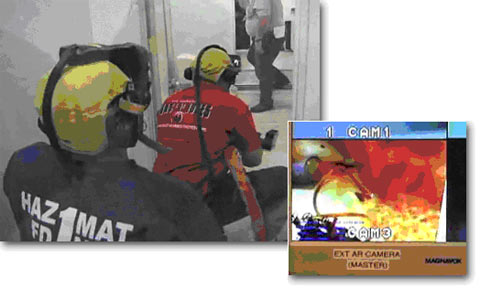
- Imagine how you might apply the technique shown in this next video to the printed materials that your learners use, or that their instructors display on classroom monitors: http://www.youtube.com/watch?v=iT2ek8N0VlY&NR=1
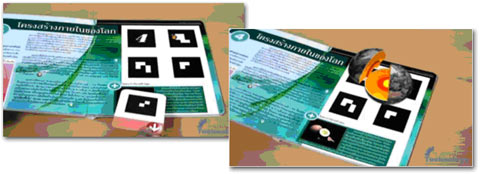
- And here’s a popular AR concept demo from GE (click the “See How It Works” thumbnail in the window that opens): http://ge.ecomagination.com/smartgrid/?c_id=googaugreal&gclid=CPP14ZXW-Z4CFag65QodPGAWJA#/augmented_reality
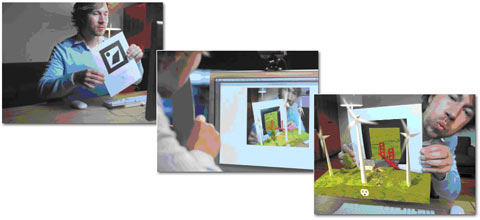
And if you crave more, here… Go crazy:
- http://www.brandrepublic.com/Discipline/Digital/News/938024/google
- http://video.google.com/videoplay?docid=6523761027552517909#docid=-7208350155329800209
- http://video.google.com/videoplay?docid=6523761027552517909#
- http://www.youtube.com/watch?v=ZKw_Mp5YkaE&feature=related
- http://www.youtube.com/watch?v=rgXzdUb_fug&feature=related
- http://www.youtube.com/watch?v=yFwzFby2eNo&feature=related
- http://www.youtube.com/watch?v=5M-oAmBDcZk&feature=related
- http://www.youtube.com/watch?v=HTYeuo6pIjY&feature=related
- http://www.youtube.com/watch?v=sxr8oaRUq6k&feature=related
- http://www.youtube.com/watch?v=29OSzQbxpcQ&feature=related
- http://www.youtube.com/watch?v=1_7NW_u3VFo&feature=related
- http://www.youtube.com/watch?v=RsehKGygClQ&feature=fvw
- http://www.youtube.com/watch?v=79Lx87MtcC0&NR=1
- http://www.youtube.com/watch?v=v9Zl1e5pAHA&feature=related
- http://www.youtube.com/watch?v=IZOeRhQdew8&feature=related
- http://www.youtube.com/watch?v=FENBx1h4cic&feature=related
Many of these applications use readily available software and ordinary PC web cams. Some (like the car-repair and Homeland Security ones) require users to wear special goggles, but many more allow people to view AR content directly on regular PC screens. Most of those ask users to hold black-and-white “marker” patterns in front of their PC web cams. These markers are like bar-codes that tell PCs which images to display, the data to show about them, and how this “virtual content” should change as students move the markers in front of their PC web cams.
Look Beyond the Fun
While viewing these videos (and others), please think about how their underlying capabilities might work in your online training. For example, this video of virtual water falling onto a researcher’s head (http://www.youtube.com/watch?v=-NAH5vlkgkk&feature=related) is cute and fun, but its important take-away is the real-time "physical" interaction between the man and the dynamic computer-generated objects.
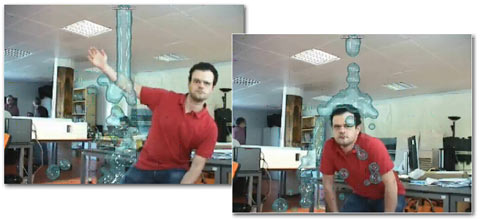
So look beyond the fun. Instead of bouncing virtual water off a student’s head, maybe your AR content might enable aeronautics students to see and explore how air flows around an aircraft model that they hold in their hands… and how this flow changes as they pitch, roll, yaw, and bank the model in front of their web cams. Each student would see different results, as they each explore their model's effect on the virtual wind flowing around it.
Do It Yourself
Want to explore AR more deeply? This site: http://www.youtube.com/watch?v=jU6PcBS1pWw&NR=1&feature=fvwp shows just one way to create your own AR applications, using Adobe Flex and a 3D-graphics program like MAYA, Blender, or even Google SketchUp. NOTE: The presentation is fast, and you must be familiar with web-page coding. But if you're technically minded and seriously interested, it’s a great tutorial.
At the end, it also mentions how to incorporate AR material into web sites and online e-Learning screens. This hints that AR content can be used right now on the SyberWorks Training Center or any other LMS that handles web-based courses.
Augmented Reality has moved from the research labs into commercial, advertising, and training applications… and even to individual content-creators’ desktops. You should definitely follow its progress if your e-Learning materials would be more effective with:
- Computer-generated course controls, navigation buttons, and other informative images overlaid on real-time real-world videos (like the car-repair example).
- Computer-generated content displayed above students' printed materials on their PC screens, or above instructor’s printed materials on classroom monitors.
Whether you need to teach “book topics” or the most complex real-time processes, AR may make it easier to:
- Teach learners and hold their interest.
- Certify their competency (including in "real-time test-bed" environments.
- Guide them through performing tasks on-the-job, after training.
Your training audience could someday be as lucky as that fortunate BMW repairman we saw earlier. I strongly believe that within the next 5 years, we’ll all be incorporating at least some AR in our training programs and user documentation… either because we want to, or because our competitors did it first.
About the Author:
Dave Powell is Documentation Manager for SyberWorks Inc., a privately-held supplier of e-Learning software and training. For the past 15 years, he has written award-winning marketing collateral and user documentation for hardware/software companies like PictureTel, 3Com, Philips Medical Systems, Polaroid, and SyberWorks. Prior to that, he edited and wrote for publications like Computerworld, Infosecurity News, Networking Management, Digital Design, LightWave, Popular Computing, Harvard Business Review, and Leaders. (During that time, he also served as an author and Editorial Advisor for Sesame Street.)
About SyberWorks
SyberWorks, Inc. is a leader in providing Learning Management Systems and custom e-Learning Solutions for Fortune 1000 corporations, higher education, and other organizations. Located in Waltham, Massachusetts, the company serves the multi-billion-dollar e-Learning market. Since 1995, SyberWorks has developed and delivered unique and economical solutions for creating, managing, measuring, and improving e-Learning programs at companies and organizations in the United States, Canada, Europe, and other countries.

